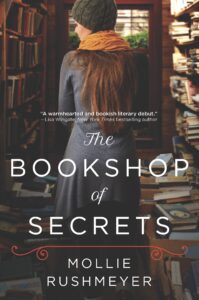By Mollie Joy Rushmeyer, @mollierushmeyer
The psychology geek in me is super excited about this topic. Although I’m no longer directly working in my field of study (psychology), I’ve never stopped being fascinated with people, the human mind, emotions, and memory, and how they’re all intertwined. If anything, psychology has played a huge role in my writing. Because what is story if not a plunge into the life and psyche of its main characters?
But, for our readers, how do we ensure our characters and their stories remain in their memories and have the greatest impact?
“I have come home at last! This is my real country! I belong here. This is the land I have been looking for all my life, though I never knew it till now…Come further up, come further in!”
― C.S. Lewis, The Last Battle, Chronicles of Narnia
These are some of my favorite words spoken in a beloved book. They are from the final scene of the last book in the Chronicles of Narnia series. Our beloved characters are alive again in the heavenly realm. A scene that never ceases to bring a smile to my lips nor a tear to my eye. And just as I’m sure the characters live on in perpetuity after I turn that last page, so too does my warm nostalgic feeling when I recall this story, time and again. The characters of many a favorite book come to mind–Elizabeth Bennett, Anne Shirley, Margaret Hale, Frodo Baggins, Samwise Gamgee, and many others–all of whom have stayed with me all these years. But why?
According to The Memory Experience: A Journey of Self Discovery, “Our emotions and our memories are inexorably linked. On one level, emotional memory simply refers to the notion that very emotional events are often memorable… Furthermore, we’re more likely to remember any image if we ourselves are in a state of heightened emotion.”
Okay, so what does this have to do with our stories, our writing?
Imagine for a moment… You’re curled up in your favorite reading spot. Are you cozy? Make sure a warm drink is beside you and cover those toes with a soft throw blanket. (Come on, it’s February in Minnesota. Indulge me.) Now imagine you’re reading one of your favorite books.
Maybe in your best-loved story, the hero finally gets the girl. Or maybe the mystery that had you reading well into the night to find out who dunnit, is finally solved. Perhaps the epic showdown between good versus evil is won.
Pause to sigh. Beautiful, isn’t it? The ache in the center of the chest as we recall the characters we love, who are so real and dear to us. The stories and the characters become part of our memories, as real as the emotions they brought out in us. They create a sense of nostalgia as we remember them, don’t they?
C.S. Lewis had it right—our hearts sing as we recall them and read them again and again, “I have come home at last!… I belong here.”
So, the question becomes, how do we as writers create a story that is memorable?
There’s no cookie-cutter answer. And let’s face it, despite our best efforts and intentions peoples’ tastes in books are as varied as the people themselves, and *squirm* our stories full of our blood (hopefully not literally), sweat, and tears may not be everyone’s cup of tea.

But… there are still things we can do to tap into the psyche of nostalgia and emotional memory to have a greater impact on readers.
- Use the five senses. I know, this is an oldie, but goodie. Think about the most impactful memories you have, the ones burned into the recesses of your brain. Because of the emotional intensity, you probably can see it in your mind like a movie. You might recall the sounds, taste, smell, and touch of the things present. There’s a reason scientists say certain smells are one of the best gateways to memory.
In the same way, when someone reads a story with a mix of high emotion and sensory details, the more likely it is to have an impact like real-life memories.
- Write from your own sense of nostalgia and emotional memory. Have you ever heard the quote by Robert Frost, “No tears in the writer, no tears in the reader”?
In the first draft especially, write like no one’s looking. Let the heart out of the ribcage to lay bare and raw upon the page. It’s not always comfortable to go to the deepest places of our own souls, our emotions, in order to take the reader to that place with us. But it will pay off.
I do want to be sensitive to people dealing with trauma and I recognize some topics may be triggering for these individuals. Please seek help, and turn to God with these hurts before attempting this.
And while we know as writers, putting our characters through emotional stress keeps readers on their toes and turning pages, from a scientific standpoint, happy and pleasurable circumstances also leave a lasting impression. In fact, some studies have shown that positive memories stay with us longer and are preserved in greater sensory detail in our brains. So, sprinkling in some good stuff for your heroes and heroines (you know, before you rip them away again), is a good thing too.
- Create characters in whom the reader can see a piece of themselves and feel for their plight. When we can see ourselves in the characters we love, we can see the roses among the thorns. All their good despite their bad. And we LOVE them for it. We ache for their aches. We laugh with their joys. We cry for all the pain they are going through. Their stories become our stories. Readers will see themselves. Not perfect, but in all their weakness, a person worth saving, worth remembering.
- Touch on a wide variety of emotions. We know that in a dark gothic mystery, there won’t be a ton of light-hearted laughter going on, nor should there be. For each genre, there’s a “mood” intentionally set. However, that doesn’t mean a writer can’t include the spectrum of emotions in his or her writing. The broad range makes a more well-rounded impression on the psyche of the reader, helping to further cement the story into their memory. Don’t we all love a movie or book that runs the gambit from laughing to crying and back again, bringing us on an emotional rollercoaster? It makes that last scene or page that much more bittersweet when it’s done.
Joy with sadness fraying at the edges—usually because we want to go back and live through it all over again through the characters we cherish–that’s the sweet spot, my friend, in which we want our stories to live. To breathe on, immemorial, in the minds and hearts of our beloved readers.
Come further up, come further in… bring on the stories with heart and emotion, writers. Blessings and prayers for you all as you write what the Lord has laid on your hearts. May they be of greatest impact for His kingdom.
A collection of lost books holds the clues to her family’s legacy…and her future.
Hope Sparrow has mastered the art of outrunning her tragic past, learning never to stay anywhere too long and never to allow anyone control over her life again. Coming to Wanishin Falls in search of her family’s history already feels too risky. But somewhere in the towering stacks of this dusty old bookshop are the books that hold Hope’s last ties to her late mother—and to a rumored family treasure that could help her start over.
Only, the bookshop is in shambles, and the elderly owner is in the beginning stages of dementia and can’t remember where the books lie. To find the last links to the loved ones she’s lost, Hope must stay and accept help from the townsfolk to locate the treasured volumes. Each secret she uncovers brings her closer to understanding where she came from. But the longer she stays in the quaint town, the more people find their way into the cracks in her heart. And letting them in may be the greatest risk of all…

Mollie Joy Rushmeyer writes “Contemporary Fiction with a Heart for History.” She loves to write inspirational fiction in contemporary settings with fascinating historical elements, people, objects, and stories woven throughout. A modern girl herself, she wouldn’t want to go a day without modern plumbing. But she’s always felt a special connection to the past. The legacies and lives left behind are like gifts waiting to be unwrapped, and she shares this blend of history and contemporary living with readers.
A born and bred Midwestern gal, Mollie, makes her home in Minnesota with her husband and two spunky daughters. She is not only a bibliophile (the dustier the better, in her opinion), she’s a true anglophile at heart. Tea and coffee fuel her travels, by Google maps at least, and her passion for the written word.
Her debut novel, The Bookshop of Secrets, with Love Inspired Trade/Harlequin released October 25th, 2022. And her second, The Lost Manuscript, will be available August of 2023.
She’d love to connect through social media: https://www.facebook.com/mollie.rushmeyer and https://www.instagram.com/molliejoyrushmeyer/
And don’t forget to sign up for her newsletter (visit www.molliejrushmeyer.com) for vintage recipe reboots, history mixed with modern living, tea and book pairings, exclusive giveaways, and a FREEBIE pdf download “10 Vintage Hacks for Modern Homes.”



Comments 1
Excellent post! Thank you, Mollie!